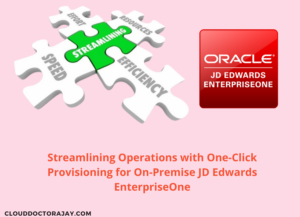Introduction:
In today’s digital landscape, protecting critical business data is of paramount importance. For organizations using JD Edwards EnterpriseOne (JDE E1), a robust data backup and recovery strategy is crucial to safeguarding valuable information and ensuring continuous business operations. This blog aims to explore various backup and recovery strategies for JDE E1, highlighting key considerations to maximize data security and minimize downtime in the event of an unforeseen disaster.
1. Understanding JDE E1 Backup and Recovery:
To begin, it is essential to have a solid understanding of JDE E1 backup and recovery processes. JDE E1 databases typically include multiple components such as the Central Objects Database (COD), Address Book (F0101), Business Data (F0901), among others. Each of these components requires a tailored backup approach to ensure comprehensive protection.

Enhancing Communication with Azure Speech Services
2. Choosing the Right Backup Method:
Several backup methods are available for JDE E1, including full backups, incremental backups, and differential backups. Each has its own advantages and considerations. Full backups provide a complete copy of the entire JDE E1 environment, while incremental backups focus on backing up only changed data since the last backup. On the other hand, differential backups capture changes since the last full backup.
3. Establishing Regular Backup Schedules:
To maintain data integrity and reduce the risk of data loss, it is crucial to establish regular and consistent backup schedules. This can be determined based on the organization’s Recovery Point Objective (RPO) and Recovery Time Objective (RTO). Consideration must be given to the frequency of changes in JDE E1 as well as the availability of backup systems and resources.
4. Offsite and Cloud Backups:
To enhance data security and protect against physical disasters, organizations should consider offsite backups and cloud-based solutions. Offsite backups involve storing backups in remote locations away from the primary data center, ensuring data redundancy and availability in the event of a catastrophic event. Cloud backup solutions provide added convenience, scalability, and rapid recovery options.
5. Testing Backup and Recovery Procedures:
No backup strategy is complete without regular testing and validation of backup and recovery procedures. Organizations should conduct periodic tests to ensure that backups are successful and can be restored accurately. Testing also helps identify any potential issues or gaps in the backup and recovery process and allows for immediate corrective measures.
Exploring Azure Kubernetes Service and Azure Container Instances for AI Model Deployment
6. Implementing Data Encryption:
Data encryption significantly enhances data security during backups. By encrypting JDE E1 data, organizations can protect sensitive information from unauthorized access, even if the backups fall into the wrong hands. Advanced encryption technologies, such as Transparent Data Encryption (TDE), provide an extra layer of security and compliance.
7. Disaster Recovery Planning:
In addition to backups, organizations should have a comprehensive disaster recovery (DR) plan in place. A DR plan outlines the necessary steps and processes to resume business operations in the event of a disruption. It includes considerations for data recovery, system restoration, and business continuity, ensuring minimal downtime and data loss.
Conclusion:
A well-designed backup and recovery strategy for JDE E1 is vital to protect critical business data, maintain data integrity, and enable swift recovery in the face of unexpected events. By implementing appropriate backup methods, regular testing, offsite backups, data encryption, and disaster recovery planning, organizations can effectively safeguard their JDE E1 environment and ensure business continuity, even in the event of a disaster.




